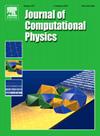Boosting the convergence of DSMC by GSIS
IF 3.8
2区 物理与天体物理
Q2 COMPUTER SCIENCE, INTERDISCIPLINARY APPLICATIONS
引用次数: 0
Abstract
A deterministic-stochastic coupling scheme is developed for simulating rarefied gas flows, where the key process is the alternative solving of the macroscopic synthetic equations [Su et al. (2020) [22]] and the mesoscopic equation via the asymptotic-preserving time-relaxed Monte Carlo scheme [Fei (2023) [19]]. Firstly, the macroscopic synthetic equations are exactly derived from the Boltzmann equation, incorporating not only the Newtonian viscosity and Fourier thermal conduction laws but also higher-order constitutive relations that capture rarefaction effects; the latter are extracted from the stochastic solver over a defined sampling interval. Secondly, the macroscopic synthetic equations, with the initial field extracted from the stochastic solver over the same sampling interval, are solved to the steady state or over a certain iteration steps. Finally, the simulation particles in the stochastic solver are updated to match the density, velocity, and temperature obtained from the macroscopic synthetic equations. Moreover, simulation particles in the subsequent interval will be partly sampled according to the solutions of macroscopic synthetic equations. As a result, our coupling strategy enhances the asymptotic-preserving characteristic of the stochastic solver and substantially accelerates convergence towards the steady state. Several numerical tests are performed, and it is found that our method can reduce the computational cost in the near-continuum flow regime by two orders of magnitude compared to the direct simulation Monte Carlo method.
求助全文
约1分钟内获得全文
求助全文
来源期刊

Journal of Computational Physics
物理-计算机:跨学科应用
CiteScore
7.60
自引率
14.60%
发文量
763
审稿时长
5.8 months
期刊介绍:
Journal of Computational Physics thoroughly treats the computational aspects of physical problems, presenting techniques for the numerical solution of mathematical equations arising in all areas of physics. The journal seeks to emphasize methods that cross disciplinary boundaries.
The Journal of Computational Physics also publishes short notes of 4 pages or less (including figures, tables, and references but excluding title pages). Letters to the Editor commenting on articles already published in this Journal will also be considered. Neither notes nor letters should have an abstract.
 求助内容:
求助内容: 应助结果提醒方式:
应助结果提醒方式:


